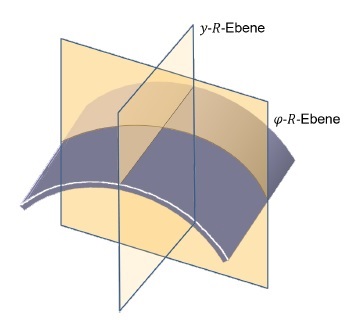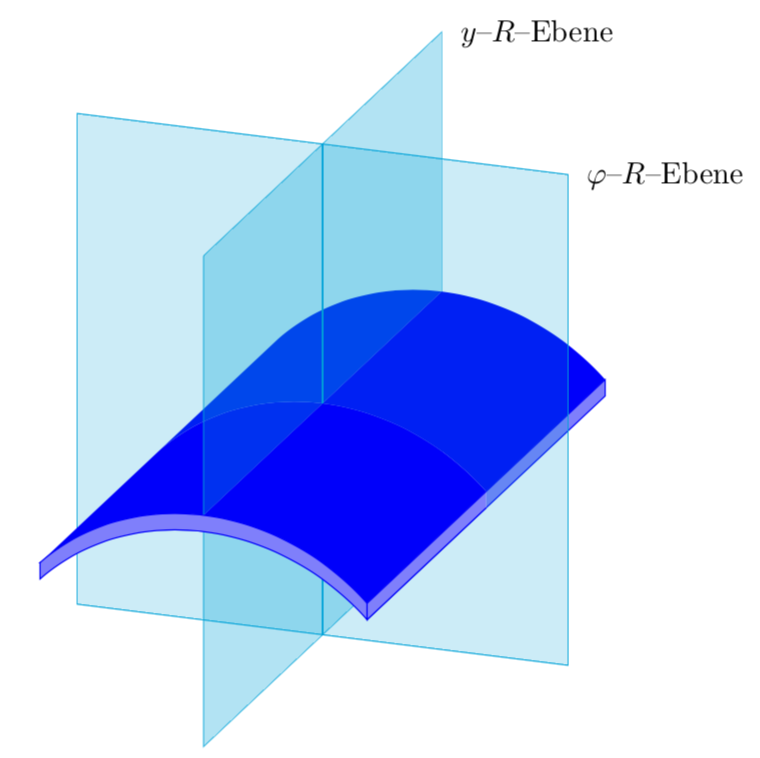|
Kann irgendjemand mir sagen, wie ich am einfachsten zwei Symmetrieebene vom folgenden Teilzylinder (wie das Bild) darstellen lassen kann? \documentclass[]{article} \usepackage{tikz} \begin{document} \begin{tikzpicture} \draw[line width=0.1mm,black] ([shift=(200:102pt)]0,0) arc (200:320:102pt); \draw[line width=0.1mm,black, dashed] ([shift=(200:102pt)]2,2) arc (200:320:102pt); \draw[line width=0.1mm,black, yshift=3pt] ([shift=(200:95pt)]0,0) arc (200:320:95pt); \draw[line width=0.1mm,black, yshift=3pt] ([shift=(200:95pt)]2,2) arc (200:320:95pt); \draw[line width=0.1mm, black] (-3.13,-1.04) -- (-1.135,0.97); \draw[line width=0.1mm, black, yshift=-13,xshift=-4, dashed] (-3.22,-0.76) -- (-1.225,1.25); \draw[line width=0.1mm, black] (-3.13,-1.04) -- (-3.365,-1.21); \draw[line width=0.1mm, black, dashed] (-1.38,0.76) -- (-1.135,0.97); \draw[line width=0.1mm, black] (2.56,-2.03) -- (2.74,-2.3); \draw[line width=0.1mm, black, yshift=-14,xshift=0.1] (4.735,0.2) -- (2.735,-1.82); \draw[line width=0.1mm, black] (2.56,-2.04) -- (4.56,-0.03); \draw[line width=0.1mm, black,yshift=56.9,xshift=56.9] (2.56,-2.03) -- (2.735,-2.3); \end{tikzpicture} \end{document} |
|
TikZ hat im Gegensatz zu asymptote keine wirkliche 3D Engine. Also muss man die einzelnen Segemente und Ebenen Stück für Stück zeichnen. Zuerst das links-hinten Segment vom Zylinder, dann die Halbebenen, die es verdecken, dann rechts hinten usw. \documentclass[border=5pt]{standalone} \usepackage{tikz,tikz-3dplot} \begin{document} \tdplotsetmaincoords{70}{110} \begin{tikzpicture}[tdplot_main_coords] \tdplotsetrotatedcoords{0}{90}{90} \begin{scope}[tdplot_rotated_coords] % Segment links hinten \fill[blue] (-2,-2,-2) arc(135:90:{2*sqrt(2)}) -- ++(0,0,4) arc(90:135:{2*sqrt(2)})--cycle; % Halbebene oben \draw[fill opacity=0.3,fill=cyan,cyan] (0,-4,-2) -- (0,-4,2) -- (0,2,2) -- (0,2,-2) -- cycle; % Halbebene links \draw[fill opacity=0.2,fill=cyan,cyan] (-3,-4,2) -- (0,-4,2) -- (0,2,2) -- (-3,2,2) -- cycle; % Segment links vorne \fill[blue] (-2,-2,2) arc(135:90:{2*sqrt(2)}) -- ++(0,0,4) arc(90:135:{2*sqrt(2)})--cycle; % Halbebene unten \draw[fill opacity=0.3,fill=cyan,cyan] (0,-4,2) -- (0,-4,6) -- (0,2,6) -- (0,2,2) -- cycle; % Segment rechts hinten \fill[blue] (2,-2,-2) arc(45:90:{2*sqrt(2)}) -- ++(0,0,4) arc(90:45:{2*sqrt(2)})--cycle; % das macht den Zylindermantel dick \fill[blue!50] (2,-2,-2) -- ++(0,0,4) -- ++(0,-0.2,0) -- ++(0,0,-4) -- cycle; \draw[blue] (2,-2,2) -- ++(0,0,-4) -- ++(0,-0.2,0) -- ++(0,0,8); % Halbebene rechts \draw[fill opacity=0.2,fill=cyan,cyan] (0,-4,2) -- (3,-4,2) -- (3,2,2) -- (0,2,2) -- cycle; % Segment rechts vorne \fill[blue] (2,-2,2) arc(45:90:{2*sqrt(2)}) -- ++(0,0,4) arc(90:45:{2*sqrt(2)})--cycle; % das macht den Zylindermantel dick \draw[blue,fill=blue!50] (-2,-2,6) -- ++(0,-0.2,0) arc(135:45:{2*sqrt(2)}) -- ++(0,0.2,0) arc(45:135:{2*sqrt(2)}) --cycle; \fill[blue!50] (2,-2,2) -- ++(0,0,4) -- ++(0,-0.2,0) -- ++(0,0,-4) -- cycle; \draw[blue] (2,-2,2) -- ++(0,0,4) -- ++(0,-0.2,0) -- ++(0,0,-4); \node[anchor=west] at (3.1,2,2){$\varphi$--$R$--Ebene}; \node[anchor=west] at (0.1,2,-2){$y$--$R$--Ebene}; \end{scope} \end{tikzpicture} \end{document} |


